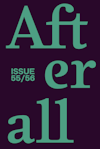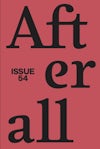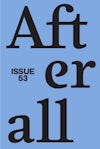
Issue 35
Spring 2014
Issue 35 examines art’s relationship to its economic context through the work of Olga Chernysheva, Teatro da Vertigem and Tony Chakar. Accompanying essays reflect upon the conditions of circulation and appreciation of art, and its entanglement within the systems of value that it often aims to critique.
Editors: Melissa Gronlund, Anders Kreuger, Pablo Lafuente, Stephanie Smith, Nuria Enguita Mayo, Helena Vilalta, Louise O’Hare.
Founding editors: Charles Esche, Mark Lewis.
Table of contents
Foreword
Contextual Essays
- Occupy 21st Street! Helen Frankenthaler at Gagosian – Shepherd Steiner
Artists
Tony Chakar
- Tony Chakar: To Speak Shadow
- Tony Chakar: On Black Holes – Haig Aivazian
Teatro da Vertigem
- Teatro da Vertigem (and the City of São Paulo) – Marcos Moraes
- Performing the ‘Thing’: Teatro da Vertigem’s Bom Retiro 958 metros – Diana Taylor
Olga Chernysheva
- On the Humility of Modern Life: Olga Chernysheva’s Notes and Reflections – Ekaterina Degot
- Mundane Virtuosity: Olga Chernysheva’s Work on Video – Robert Bird
Events, Works, Exhibitions
- Circus Architecture: Ângela Ferreira’s ‘Zip Zap Circus School’ – Filipa Oliveira
- Less Sauvages than Others: Rosemarie Trockel’s ‘A Cosmos’ – Brigid Doherty
- Compulsion to Repeat: Max Ophüls’s ‘Lola Montès’ – Laura Mulvey
- Responding to the Relations and Conditions of Exhibitions: The ‘Services’ Working-Group Discussion Forum – Eric Golo Stone
Foreword
Written by Anders Kreuger
‘How to Read an Art Journal.’ This was the title of an impromptu seminar I gave, some ten years ago, at an art academy in a rarely visited part of Scandinavia. The students wanted to know how they might avoid catching mild forms of attention deficit disorder as they leafed through the journals of their nicely appointed school library. Looking at the pictures, reading a caption here and there, intuiting likes and dislikes but not quite remembering the names of the artists featured: these are the kind of things we are all guilty of but which art students are not yet ashamed to admit to. And since I knew one or two things about art journals, I accepted the challenge and showed up at the agreed-upon time with a pile of publications that will remain unnamed here.
As I remember it, the difficult part was deciding how cynical — or perhaps I should say honest — to be when pointing out the strategy and tactics at play in the composition of an art journal, which is really just another trade journal. If we know which galleries represent which artists we will see the connections between advertising and editorial content; if we know what exhibitions have just taken place, or are being planned, we will understand why certain curators or artists were asked to contribute: the kind of things that demonstrate how improving contextual knowledge does not automatically cure cultural anxiety. Yet I hope I conveyed the message that, despite their flaws, art journals are necessary tools for anyone who wants to live in the art world, and that they should be consumed cunningly but with as little cynicism or opportunism as possible.
My colleagues and I like to believe that Afterall promotes values other than easy recognition or quick return on investment, and we do what we can to make it more than a trade journal. We also like to believe that the quality of the material featured in our journal reflects the quality of the choices we make to structure each issue around a set of concerns. And we certainly like to believe that these pages offer writing that not only enhances understanding of the subject matter it conveys but also has intrinsic aesthetic qualities. Ambitious goals, I admit, but they make us aspire for the best, and I must say I’m glad to write the foreword to this 35th issue of Afterall, which delivers goods of a kind that we can really be proud of.
I don’t mean to be self-congratulatory, only to pay respect to the artists and writers who have given us such good value. (One of the contributors, Tony Chakar, occupies both positions, which earns him our gratitude twice over.) I also want to indicate some connections among the diverse topics this issue covers. Any act of composition involves both design and chance, predictability and contingency, and to us this seems to be particularly true of putting together Afterall three times a year. We aim at always presenting three kinds of texts: contextual essays; essays that portray an artist’s practice or oeuvre; and essays that discuss particular works, exhibitions or events. In the end these categories are not always obvious, just as clear distinctions among context, oeuvre, work and event cannot always be upheld outside the covers of our journal. Quite a few of the choices we make are preprogrammed with ambiguity or transgression.
That, to be sure, is also true this time. In the contextual essay, Shepherd Steiner analyses a recent posthumous exhibition of Helen Frankenthaler’s early works at Gagosian Gallery’s Chelsea venue in New York. He provides thorough, uncompromising description and judgement of how today’s high-end contemporary art market works (context), but also of the works on display (oeuvre, exhibition), how they have been theorised throughout the decades (context again, but also another aspect of the oeuvre) and what Frankenthaler’s art and this exhibition tell us about different kinds of value, including the ‘aesthetic value’ championed by Clement Greenberg (who was her partner in the 1950s) and what Steiner calls ‘face value’ (a notion that touches on context, oeuvre, work, exhibition and event).
Purchase
The publication is available for purchase. If you would like specific articles only, it is also available individually and to be downloaded as PDFs.
Purchase full publication
Buy via University of Chicago Press
Buy via Central Books
Purchase individual articles
Buy via University of Chicago Press



